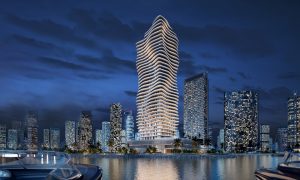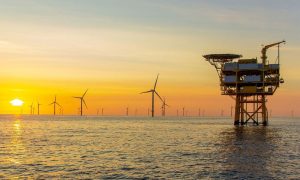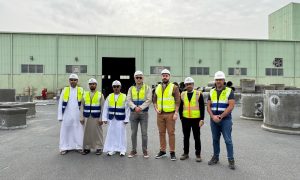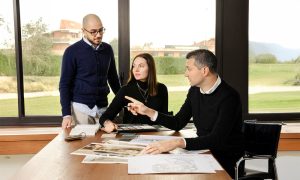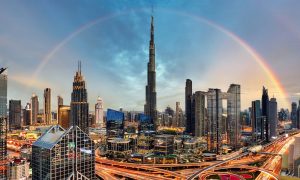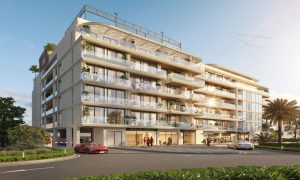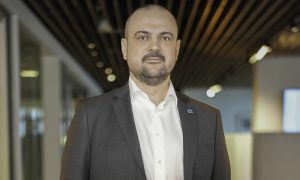Big block builders
CMME joins FBA on its mammoth job at Doha’s New Port Project to see one of the Middle East’s biggest pouring operations. Boredom masquerading as cynicism has crept into most discussions on the construction centred around Qatar. The long lead time to the World Cup in 2022 and the re-adjustment of the predating Vision 2030 […]

CMME joins FBA on its mammoth job at Doha’s New Port Project to see one of the Middle East’s biggest pouring operations.
Boredom masquerading as cynicism has crept into most discussions on the construction centred around Qatar. The long lead time to the World Cup in 2022 and the re-adjustment of the predating Vision 2030 plans to invest in the country’s future has left many wondering if the optimism of last year was real or imagined.
However the soon to open New Doha International Airport, the recent spate of infrastructure contracts and the enormous Doha’s New Port Project are all signs that the country of Qatar can really put a shift in when it wants to.
The existing port, located in the heart of the city, is currently viewed as a major bottleneck to the development of Qatar. Once completed the new port will quadruple volumes enabling Qatar to meet its obligations to deliver the stadiums, hotels and infrastructure required for the FIFA World Cup in 2022. The annual cargo handling capacity will be the equivalent of six million 20-foot equivalent units.
July saw the first precast concrete block being laid into place on its 8 km-long quay wall. It was the first in a series of 35,000 that will be needed to build the quay wall. With each block weighing between 40 to 90 tonnes each this is a mammoth task in almost every way possile.
CMME was lucky enough to be taken onto the construction of the New Port Project last month, meeting the organisation tasked with deploying the four Putzmeister Telebelt TBS 130s (telebelt = telescopic belt conveyor) that are handling the pouring work. It was hot and dusty out there. It was fun.
First though CMME met with FBA’s (Fahed Bin Abdulla Ready Mix) Khalid Ali, project manager. FBA is a sub contractor with China Harbour Company for the project. The company’s scope of work for that project includes pouring 4 million cubic meter of concrete.
“The general idea from the government about the project was to make it one of the biggest in the gulf,” he explains.
The first phase of the project began in 2011 and is schedule to finish in 2016. He says that the port is expected to cost 25.6 billion riyals ($7 billion).
“It will be about 25 km2 at the end of the first phase,” he continues.
He says that since January, China Harbour has managed to excavate about half of the 4 million cubic metre needed for the concrete pour.
“They have made that excavation in that area and are recycling the material elsewhere,” Ali explains. “It’s a big job, they have almost 300 machines.”
A wall is built out of pre-cast that makes the port and as they are dredging beyond they are excavating back filling the wall and they put a concrete wall to make a pier.
They have a breakwater wall that keeps the sea from disturbing the ships in the port.
In regards to FBA’s own substantial contribution to the operation he says that it will take three years to pour the 3 million cubic metre pre-cast blocks. They will not all be doing the same job.
“For the quay wall, we will use about 1.8 million. This is what we are building right now.”
The port itself will be a mixture of naval and commercial buildings. Hagog says that the dredging work for the project will span 300 m and go 15 m
deep: “This is a huge project. Qatar has a lot of money and they want to improve it by big project like this.”
Despite the perceived slow-ness in Qatar’s progress, he says that the company is already seeing a change in the prices of materials.
“Last year the price for ready-mix was 380 riyals per cm3 it is now 80 riyals less.
“There is no stability in prices and a shortage in material. There is a lot of competition but really it is about not having enough stability.”
Ali says that the media has played its part in bringing uncertainty to the market, covering ghost projects and mis-representing the actual state of construction activity.
However he says that until the projects relating to the World Cup start, the company will have to fight the tough conditions head on.
“We try to keep ourselves in a safe way,” he says. “Sometimes a big project comes to you and you succeed sometimes you don’t.
“Maybe you’ll be a success and maybe you’ll be a failure but sometimes you have to take the chance.”
Onto the new port
Following our meeting CMME joins Putzmeister’s aftersales and spare parts manager Louis Franzen, local rep Ali Khodor, and Putzmeister America’s telebelt guru Don Mattews and we drive down to the coast and the project itself.
Security is handled by China Harbour and typically thorough. Once through the gates, a road twists towards the massive pouring yard. The sea is hidden from view to the west by hills and banks that are being carved out by a crew of dozens of large excavators.
The Chinese company’s task is a hefty one if it is to earn every penny of its 3.2 billion riyal contract. The project involves the digging of the port’s dockyard to a depth of 17 m and building of the port quays, also underway is the digging of a canal, the construction of 2.7 km of wave breakers and the removal of 3 million cubic metres of rock and sand.
No wonder there’s a lot of kit on site. In the distance away from our vehicle cranes stand presumably ready to lay down the new Harbour, brick by brick. Turning back towards the inland we turn into the works yard for the pouring of those blocks. The scale of the pouring work is breathtaking.
We enter at the end of the queues of concrete. Close to a kilometre away are the two massive Sany 180 batching plants that are providing the concrete. The Sany 180 Eco-Batching Plant beat a dozen concrete machinery manufacturers from UAE and China to win the port contract and will also supply the construction of the Doha Stadium from 2014.
We arrive mid-afternoon and too early for the pouring to begin. It gives us a chance to walk through the enormous production area.
The 2m-high blocks are arranged in a series of neat straight rows. Each block has keys in the bottom and the top so the wall can be built up like a giant lego set (any voids are filled with dirt from the dredging.)Gantry cranes patrol above the columns picking up cured (which takes about a month) and ready blocks onto large trucks where they can be quickly ferried down to the appropriate section of the port construction site.
It may be a relatively straightforward set-up, but this is production on the grandest scale working to the fastest of rhythms. The blocks themselves are formed in individual moulds. FBA is using the Putzmeister telebelt for the first time in Qatar (they were used on Jeddah Port) to make the blocks. As the ready-mix trucks arrive fully loaded, concrete is poured into the hopper onto the belt and the up to towards.
The US and German-made machine has many advantages for this style of work because it uses a belt instead of a pump to pour concrete. This means you can pour more quantity in shorter times. It’s also a relatively environmentally friendly machine with very high transporting capacity which can reach up to 250 m3 of concrete/hour.
Once we’re up and running the advantages of the system become very clear. The ready-mix trucks arrive in convoy, seamlessly swapping positions at the end of the belt with a very narrow set-up time. As with a concrete pump it’s operated remotely with simple controls over belt speed, positioning, etc.
Concrete pouring is almost always about speed and the mould is soon filled, with a team assembled over the pour to ensure it sets as evenly as possible. With the completion of one block, the belt swings 180-degrees to an empty box on the other side to begin the process of pouring again.
And so this process will be repeated day and night in the years ahead. It will be hard, tough and monotonous, but this is one corner of Qatar that is taking shape. And my goodness was I impressed.



